2017 KIA CARENS RHD child lock
[x] Cancel search: child lockPage 25 of 723

37
Safety features of your vehicle
3. To use the front passenger’s seat,lift and pull the seatback backward
by pulling on the folding lever.
Pull the seatback firmly until it
clicks into place. Make sure the
seatback is locked in place.Seat cushion height (if equipped)
To change the height of the seat
cushion, push the lever upwards or
downwards.
To lower the seat cushion, push down the lever several times.
To raise the seat cushion, pull up the lever several times. Front seat adjustment - power (if equipped)
The driver’s seat can be adjusted by
using the control switches located onthe outside of the seat cushion.
Before driving, adjust the seat to theproper position so as to easily con-
trol the steering wheel, pedals and
switches on the instrument panel.
WARNING
Do not fold the front passen- ger’s seat, if the occupants in
the 2nd row centre and front
passenger’s side seats. It may
cause the injury to occupants
by the seat device.
Be careful not to pinch your hands or fingers on the seat
device, when you fold or unfold.
ORP036004R
WARNING
The power seat is operable with
the ignition OFF.
Therefore, children should never
be left unattended in the car.
Page 58 of 723
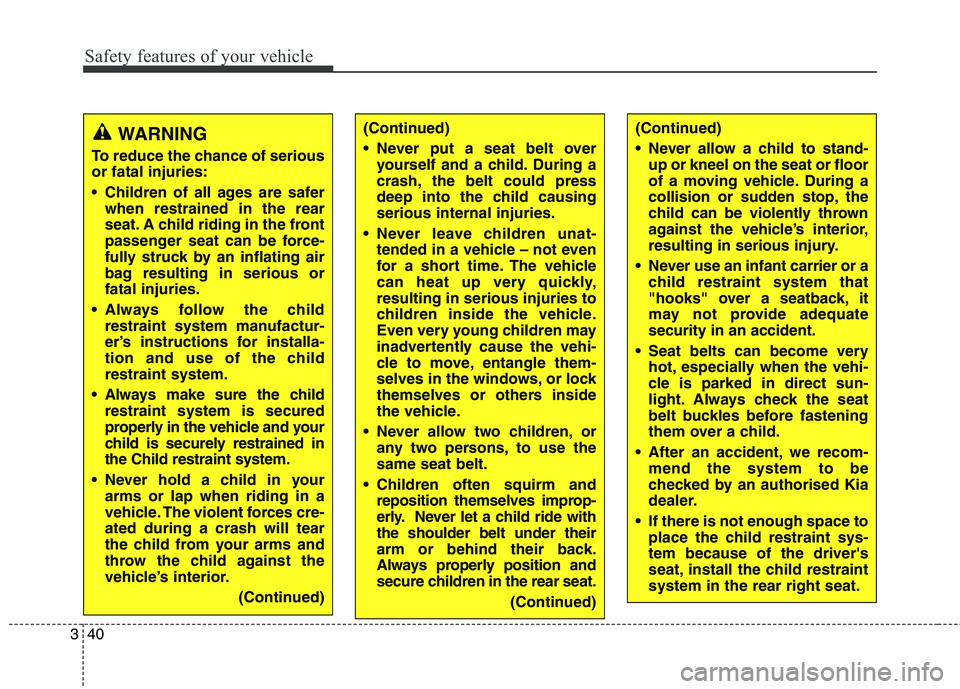
Safety features of your vehicle
40
3
WARNING
To reduce the chance of serious or fatal injuries:
Children of all ages are safer when restrained in the rear
seat. A child riding in the front
passenger seat can be force-
fully struck by an inflating air
bag resulting in serious orfatal injuries.
Always follow the child restraint system manufactur-
er’s instructions for installa-
tion and use of the childrestraint system.
Always make sure the child restraint system is secured
properly in the vehicle and your
child is securely restrained inthe Child restraint system.
Never hold a child in your arms or lap when riding in a
vehicle. The violent forces cre-ated during a crash will tear
the child from your arms and
throw the child against the
vehicle’s interior.
(Continued)(Continued)
Never put a seat belt overyourself and a child. During a
crash, the belt could press
deep into the child causingserious internal injuries.
Never leave children unat- tended in a vehicle – not even
for a short time. The vehicle
can heat up very quickly,resulting in serious injuries to
children inside the vehicle.
Even very young children may
inadvertently cause the vehi-
cle to move, entangle them-
selves in the windows, or lock
themselves or others inside
the vehicle.
Never allow two children, or any two persons, to use thesame seat belt.
Children often squirm and reposition themselves improp-
erly. Never let a child ride withthe shoulder belt under their
arm or behind their back.
Always properly position and
secure children in the rear seat.
(Continued)(Continued)
Never allow a child to stand-up or kneel on the seat or floor
of a moving vehicle. During a
collision or sudden stop, the
child can be violently thrown
against the vehicle’s interior,
resulting in serious injury.
Never use an infant carrier or a child restraint system that
"hooks" over a seatback, it
may not provide adequatesecurity in an accident.
Seat belts can become very hot, especially when the vehi-
cle is parked in direct sun-
light. Always check the seat
belt buckles before fastening
them over a child.
After an accident, we recom- mend the system to be
checked by an authorised Kia
dealer.
If there is not enough space to place the child restraint sys-tem because of the driver's
seat, install the child restraintsystem in the rear right seat.
Page 61 of 723
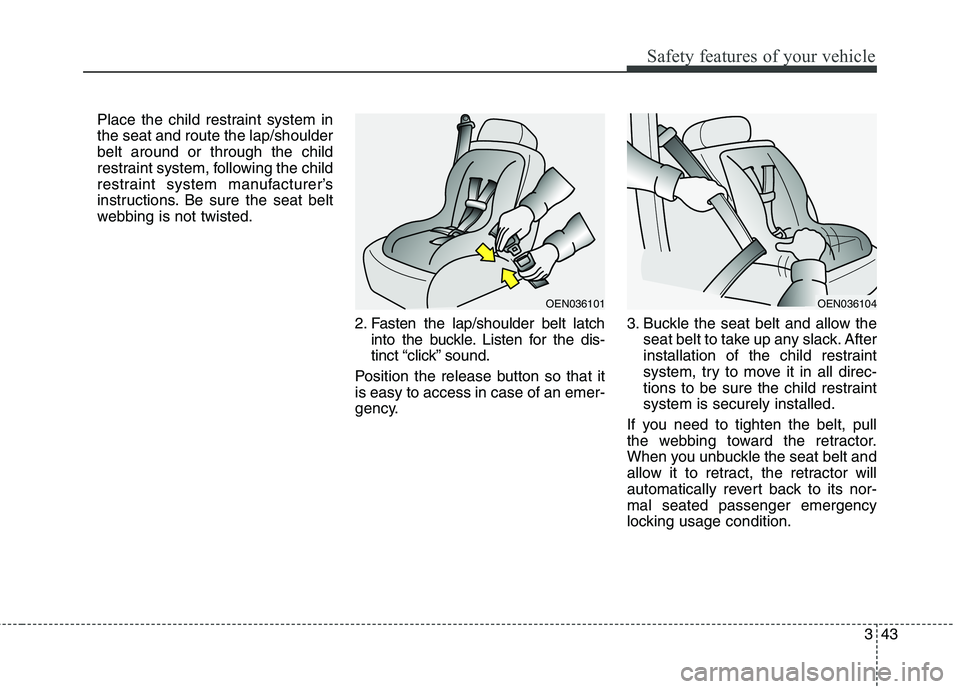
343
Safety features of your vehicle
Place the child restraint system in the seat and route the lap/shoulderbelt around or through the child
restraint system, following the child
restraint system manufacturer’s
instructions. Be sure the seat belt
webbing is not twisted.2. Fasten the lap/shoulder belt latchinto the buckle. Listen for the dis-
tinct “click” sound.
Position the release button so that itis easy to access in case of an emer-
gency. 3. Buckle the seat belt and allow the
seat belt to take up any slack. After
installation of the child restraint
system, try to move it in all direc-
tions to be sure the child restraintsystem is securely installed.
If you need to tighten the belt, pull
the webbing toward the retractor.
When you unbuckle the seat belt and
allow it to retract, the retractor will
automatically revert back to its nor-mal seated passenger emergency
locking usage condition.
OEN036101OEN036104
Page 67 of 723
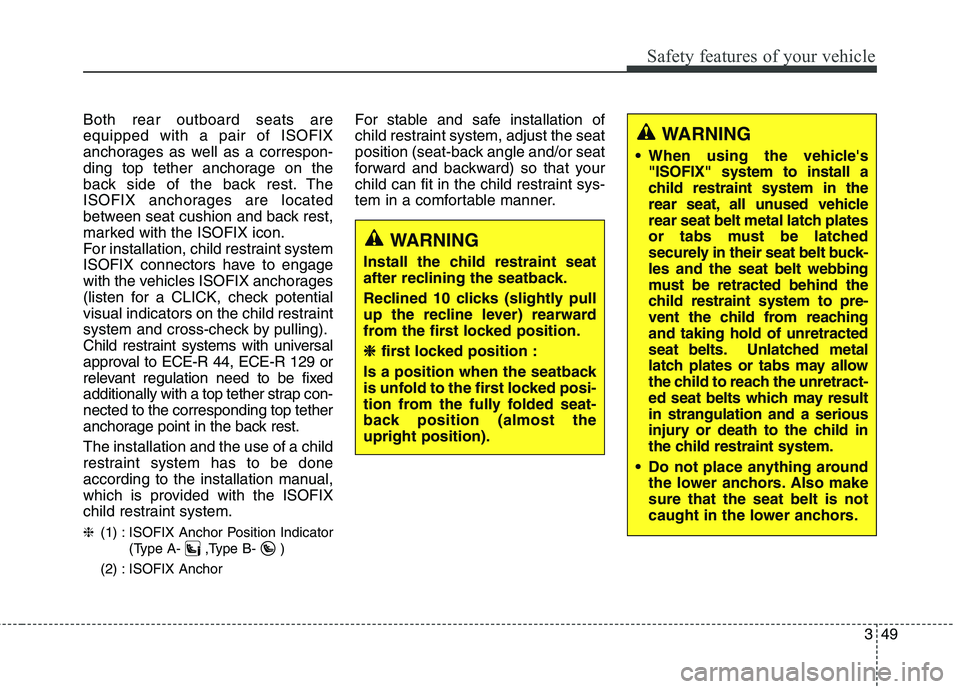
349
Safety features of your vehicle
Both rear outboard seats are equipped with a pair of ISOFIX
anchorages as well as a correspon-
ding top tether anchorage on the
back side of the back rest. The
ISOFIX anchorages are located
between seat cushion and back rest,
marked with the ISOFIX icon.
For installation, child restraint system
ISOFIX connectors have to engage
with the vehicles ISOFIX anchorages
(listen for a CLICK, check potential
visual indicators on the child restraint
system and cross-check by pulling).
Child restraint systems with universal
approval to ECE-R 44, ECE-R 129 or
relevant regulation need to be fixed
additionally with a top tether strap con-nected to the corresponding top tether
anchorage point in the back rest. The installation and the use of a child
restraint system has to be done
according to the installation manual,
which is provided with the ISOFIX
child restraint system. ❈(1) : ISOFIX Anchor Position Indicator
(Type A- ,Type B- )
(2) : ISOFIX Anchor For stable and safe installation of
child restraint system, adjust the seat
position (seat-back angle and/or seat
forward and backward) so that your
child can fit in the child restraint sys-
tem in a comfortable manner.
WARNING
Install the child restraint seat
after reclining the seatback.
Reclined 10 clicks (slightly pull
up the recline lever) rearward
from the first locked position. ❈
❈ first locked position :
Is a position when the seatback
is unfold to the first locked posi-
tion from the fully folded seat-
back position (almost theupright position).
WARNING
When using the vehicle's "ISOFIX" system to install a
child restraint system in the
rear seat, all unused vehicle
rear seat belt metal latch plates
or tabs must be latched
securely in their seat belt buck-les and the seat belt webbing
must be retracted behind the
child restraint system to pre-
vent the child from reachingand taking hold of unretracted
seat belts. Unlatched metal
latch plates or tabs may allow
the child to reach the unretract-
ed seat belts which may resultin strangulation and a serious
injury or death to the child in
the child restraint system.
Do not place anything around the lower anchors. Also makesure that the seat belt is not
caught in the lower anchors.
Page 75 of 723
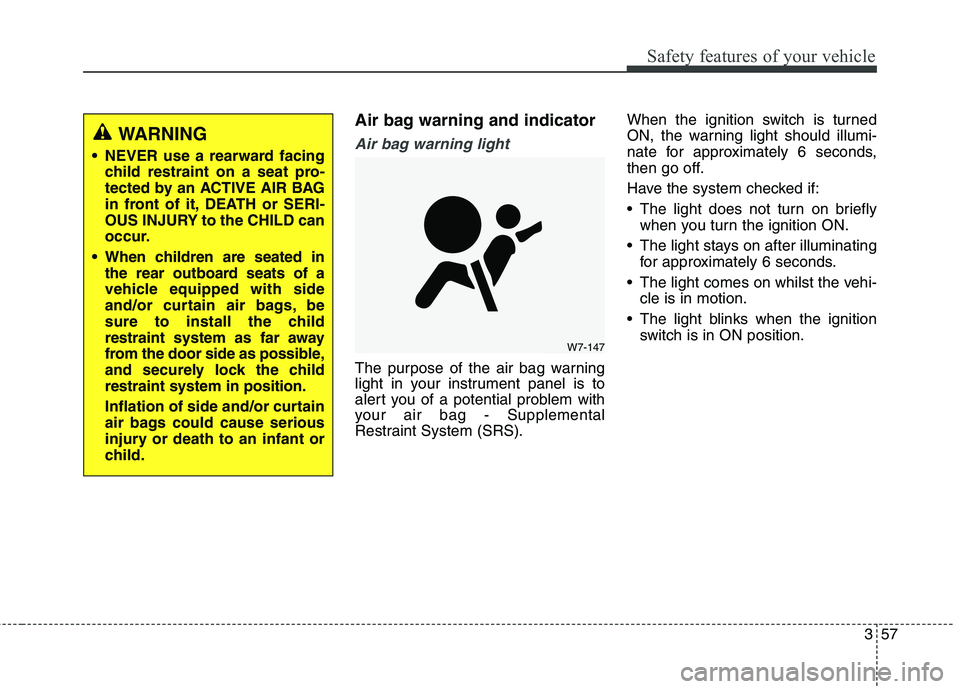
357
Safety features of your vehicle
Air bag warning and indicator
Air bag warning light
The purpose of the air bag warning
light in your instrument panel is to
alert you of a potential problem with
your air bag - Supplemental
Restraint System (SRS).When the ignition switch is turned
ON, the warning light should illumi-
nate for approximately 6 seconds,
then go off.
Have the system checked if:
The light does not turn on briefly
when you turn the ignition ON.
The light stays on after illuminating for approximately 6 seconds.
The light comes on whilst the vehi- cle is in motion.
The light blinks when the ignition switch is in ON position.
W7-147
WARNING
NEVER use a rearward facing child restraint on a seat pro-
tected by an ACTIVE AIR BAG
in front of it, DEATH or SERI-
OUS INJURY to the CHILD can
occur.
When children are seated in the rear outboard seats of a
vehicle equipped with side
and/or curtain air bags, be
sure to install the child
restraint system as far away
from the door side as possible,
and securely lock the childrestraint system in position.
Inflation of side and/or curtain
air bags could cause serious
injury or death to an infant or
child.
Page 88 of 723
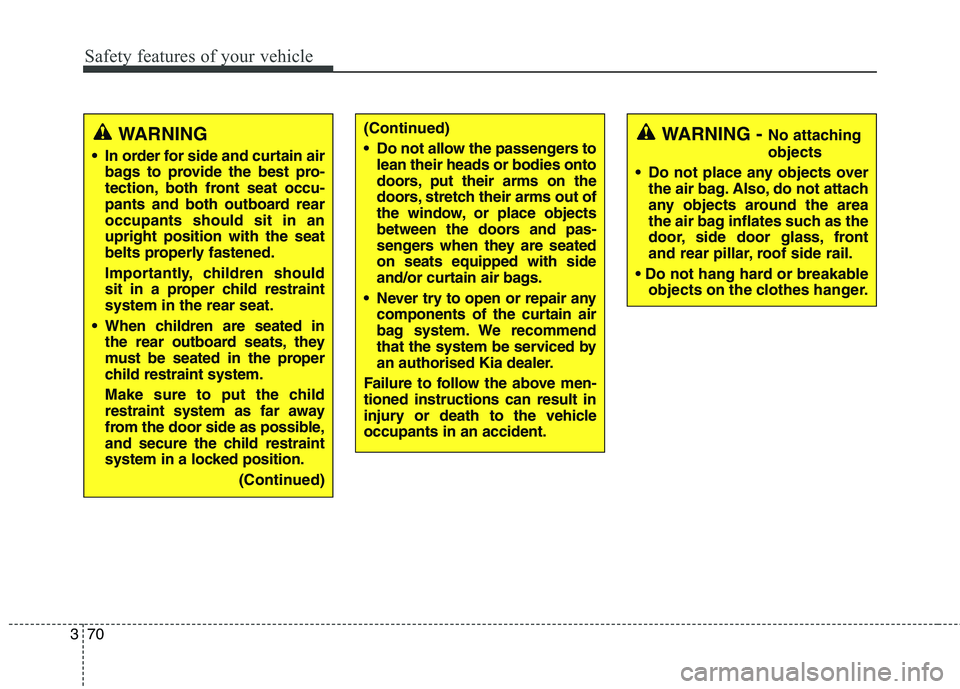
Safety features of your vehicle
70
3
(Continued)
Do not allow the passengers to
lean their heads or bodies onto
doors, put their arms on the
doors, stretch their arms out of
the window, or place objects
between the doors and pas-
sengers when they are seatedon seats equipped with side
and/or curtain air bags.
Never try to open or repair any components of the curtain air
bag system. We recommend
that the system be serviced by
an authorised Kia dealer.
Failure to follow the above men-tioned instructions can result in
injury or death to the vehicleoccupants in an accident.WARNING
In order for side and curtain air bags to provide the best pro-
tection, both front seat occu-
pants and both outboard rearoccupants should sit in anupright position with the seat
belts properly fastened.
Importantly, children should
sit in a proper child restraintsystem in the rear seat.
When children are seated in the rear outboard seats, they
must be seated in the proper
child restraint system.
Make sure to put the child
restraint system as far away
from the door side as possible,
and secure the child restraint
system in a locked position.
(Continued)WARNING - No attaching objects
Do not place any objects over the air bag. Also, do not attach
any objects around the area
the air bag inflates such as the
door, side door glass, front
and rear pillar, roof side rail.
objects on the clothes hanger.
Page 101 of 723
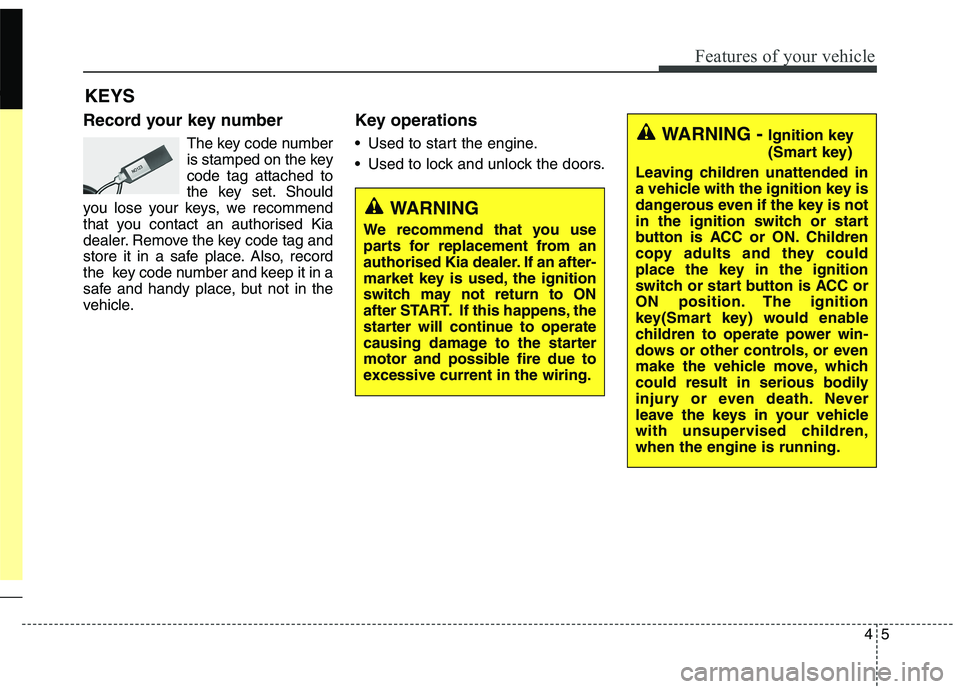
45
Features of your vehicle
Record your key numberThe key code number
is stamped on the keycode tag attached to
the key set. Should
you lose your keys, we recommend
that you contact an authorised Kia
dealer. Remove the key code tag and
store it in a safe place. Also, record
the key code number and keep it in a
safe and handy place, but not in the
vehicle. Key operations
• Used to start the engine.
Used to lock and unlock the doors.
KEYSWARNING -
Ignition key
(Smart key)
Leaving children unattended in
a vehicle with the ignition key is
dangerous even if the key is not
in the ignition switch or start
button is ACC or ON. Children
copy adults and they could
place the key in the ignition
switch or start button is ACC or
ON position. The ignition
key(Smart key) would enable
children to operate power win-
dows or other controls, or even
make the vehicle move, which
could result in serious bodily
injury or even death. Never
leave the keys in your vehicle
with unsupervised children,when the engine is running.
WARNING
We recommend that you use
parts for replacement from an
authorised Kia dealer. If an after-
market key is used, the ignition
switch may not return to ON
after START. If this happens, the
starter will continue to operate
causing damage to the starter
motor and possible fire due to
excessive current in the wiring.
Page 123 of 723
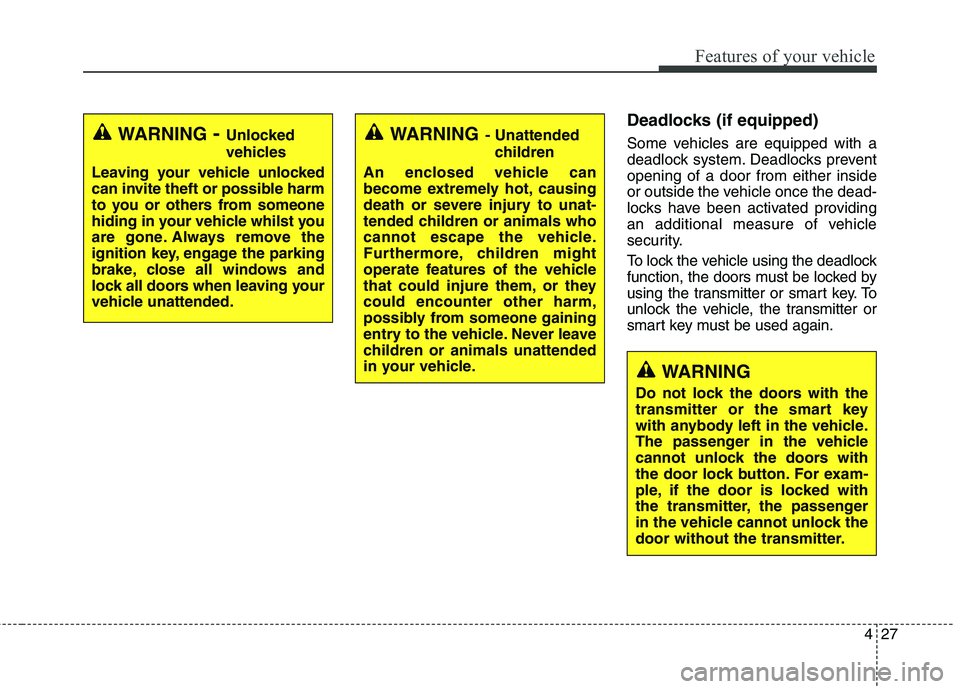
427
Features of your vehicle
Deadlocks (if equipped)
Some vehicles are equipped with a
deadlock system. Deadlocks preventopening of a door from either inside
or outside the vehicle once the dead-
locks have been activated providing
an additional measure of vehicle
security.
To lock the vehicle using the deadlock
function, the doors must be locked by
using the transmitter or smart key. To
unlock the vehicle, the transmitter or
smart key must be used again.WARNING- Unlocked
vehicles
Leaving your vehicle unlocked
can invite theft or possible harm
to you or others from someone
hiding in your vehicle whilst you
are gone. Always remove the
ignition key, engage the parking
brake, close all windows and
lock all doors when leaving your
vehicle unattended.WARNING - Unattended
children
An enclosed vehicle can
become extremely hot, causing
death or severe injury to unat-
tended children or animals who
cannot escape the vehicle.
Furthermore, children might
operate features of the vehicle
that could injure them, or theycould encounter other harm,
possibly from someone gaining
entry to the vehicle. Never leave
children or animals unattended
in your vehicle.
WARNING
Do not lock the doors with the
transmitter or the smart key
with anybody left in the vehicle.
The passenger in the vehicle
cannot unlock the doors with
the door lock button. For exam-
ple, if the door is locked with
the transmitter, the passenger
in the vehicle cannot unlock the
door without the transmitter.